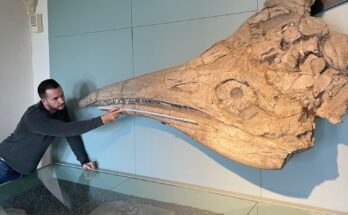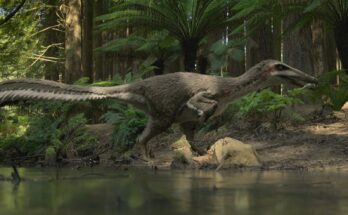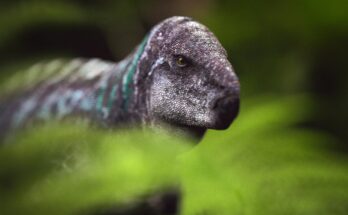🦖 Part 1: Introduction — The Myth and the Monster
If you’ve seen Jurassic Park, you probably have a very clear image in your mind of Velociraptor: a human-sized, scaly, super-smart pack hunter with razor-sharp claws and a terrifying shriek. But what if I told you the real Velociraptor was actually only the size of a turkey and covered in feathers?
The story of Velociraptor is a tale of two creatures:
- The real, scientifically accurate predator that roamed ancient Mongolia over 75 million years ago.
- The movie monster, super-sized and exaggerated for Hollywood drama.
But even without the movie magic, the real Velociraptor was an incredible animal — small, fast, smart, and deadly. It was part of a group of dinosaurs called dromaeosaurids, or “raptors,” which were close relatives of modern birds. In fact, many paleontologists believe that if you saw a Velociraptor today, you might mistake it for a giant, flightless bird with claws.
Velociraptor lived during the Late Cretaceous period, around 75 to 71 million years ago, in what is now Mongolia. It hunted small animals, scavenged when it could, and possibly even used its famous sickle claw to pin down struggling prey. While it may not have been the towering nightmare seen in movies, Velociraptor was a clever and effective predator.
Over the last century, Velociraptor has become one of the most studied — and most misunderstood — dinosaurs in the world. It’s appeared in museums, documentaries, books, toys, and of course, the Jurassic Park franchise. But the more scientists learn about it, the more incredible its real story becomes.
In this article, we’ll go beyond the Hollywood hype and uncover the true history of Velociraptor — from its discovery in the deserts of Mongolia to the latest scientific research about its feathers, brainpower, and link to birds. We’ll explore its hunting style, its place in the dinosaur family tree, and how it became one of the most beloved (and feared) dinosaurs in modern culture.

Ready to meet the real raptor? Let’s dive into its thrilling story, starting from the very first fossil that changed everything.
🧭 Part 2: The Discovery of Velociraptor — Unearthing the Raptor
The story of Velociraptor begins not on a movie screen, but in the vast, dry deserts of Mongolia — one of the most fossil-rich regions in the world. This is where, almost a century ago, one of the greatest discoveries in paleontology took place.
It was the 1920s, and the world was fascinated by ancient creatures and lost worlds. The American Museum of Natural History in New York launched a bold scientific mission to Central Asia, led by a fearless explorer and paleontologist named Roy Chapman Andrews. With camels, cars, and a crew of adventurers, Andrews journeyed into the Gobi Desert, hoping to find ancient mammals — but what they found was even more spectacular.
🦴 The First Raptor Fossil
In 1923, during one of the expeditions to the Flaming Cliffs of the Gobi Desert, a fossil hunter uncovered a small, slender skull with sharp teeth and a long snout. Along with it were parts of the skeleton, including an unusual curved claw on the second toe of the foot.
It was like nothing they had seen before.
That fossil would later be named Velociraptor mongoliensis — “Velociraptor” meaning “swift thief” in Latin. The name perfectly captured the dinosaur’s presumed agility and hunting ability. It was first officially described by paleontologist Henry Fairfield Osborn, who was also the president of the American Museum of Natural History at the time.

🐾 The Famous Killing Claw
Even in the 1920s, scientists were intrigued by one special feature: the large, curved claw on each of the Velociraptor’s second toes. It looked like a raptor’s talon — sharp, deadly, and perfect for gripping prey. This one detail would become iconic, featured in books, games, and movies for decades to come.
Over time, paleontologists began to realize that Velociraptor was part of a larger group of small, agile carnivores called dromaeosaurids, or “raptor dinosaurs.” These creatures were incredibly bird-like — not just in bone structure, but in their posture, movement, and even their feathers.
🦖 A Clash Frozen in Time: The Fighting Dinosaurs
One of the most amazing discoveries involving Velociraptor came in 1971, when a team of Polish and Mongolian scientists found a fossil showing a Velociraptor locked in battle with a plant-eating dinosaur called Protoceratops.
In this fossil:
- The Velociraptor’s sickle claw is stuck in the neck of the Protoceratops.
- The Protoceratops seems to have bitten onto the Velociraptor’s arm.
- Both dinosaurs likely died in a sudden sandstorm and were buried instantly.
This fossil is now famously called the “Fighting Dinosaurs”, and it gave scientists dramatic proof that Velociraptor used its claws to attack and pin down prey. It also showed that Velociraptor was an active predator, not just a scavenger.
🌍 More Discoveries Across the Gobi
Over the years, more Velociraptor fossils were found across the Nemegt Formation and other fossil-rich regions in Mongolia. These discoveries helped build a clearer picture of how the animal lived, what it looked like, and how it evolved.
Some fossils even preserved fine details, like the bones of the wrist and arms — features that are almost identical to those of birds.
By the 1990s and early 2000s, a new understanding of raptors was emerging. They weren’t lizard-like killing machines — they were smart, agile, feathered predators that may have been more similar to modern birds of prey than reptiles.

🔍 Why Mongolia?
Mongolia remains one of the most important places in the world for studying Velociraptor and its relatives. The dry deserts and ancient sediment layers preserve fossils in remarkable condition. That’s why most of what we know about Velociraptor today comes from Mongolian fossil beds.
📜 Summary: Key Moments in Velociraptor’s Discovery
| Year | Event |
|---|---|
| 1923 | First Velociraptor fossil found in Mongolia by Roy Chapman Andrews’ team |
| 1924 | Velociraptor officially named by Henry Fairfield Osborn |
| 1971 | Discovery of the “Fighting Dinosaurs” fossil |
| 1990s–2000s | New finds reveal bird-like features and presence of feathers |
| Present | Velociraptor becomes a paleontological icon and global superstar |
The discovery of Velociraptor didn’t just give the world a new species — it rewrote the rules of dinosaur science. It showed us that not all predators were giants like T. rex. Some were small, fast, and clever — and some were the ancestors of modern birds.


